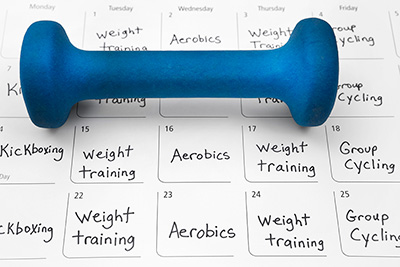Last updated May 2023
 As we discuss in our section on gyms, joinging a fitness center is only one option for exercising. You can also walk, jog, join a sports league, play tennis or pickleball, or take group classes. If you want to work out at home, you can stream classes or buy a treadmill, rowing machine, or stationary bike. Whatever workout path you take, make a commitment to stick with it. Here are strategies that can help:
As we discuss in our section on gyms, joinging a fitness center is only one option for exercising. You can also walk, jog, join a sports league, play tennis or pickleball, or take group classes. If you want to work out at home, you can stream classes or buy a treadmill, rowing machine, or stationary bike. Whatever workout path you take, make a commitment to stick with it. Here are strategies that can help:
Diet matters.
If your goal is to lose weight, know that it’s incredibly difficult to out-exercise a lousy diet. A mistake made by many who boost their activity to drop pounds is not adjusting what they eat and drink. Another mistake: rewarding yourself for hitting exercise goals with empty-calorie snacks.
Most nutrition experts agree that it’s extremely difficult for most people to lose weight and keep it off. Fad diets don’t work for long. What will work for you depends greatly on your body and genetics. Consider consulting a nutritionist to make a plan you can live with.
Assess your fitness level.
Consider getting a physical first. If you’re over 40, review any greatly ramped-up fitness plan with your physician before starting.
You can do your own assessments: Measure your pulse, blood pressure, weight, how long it takes to walk or jog a mile, how many pushups you can do, etc. If you have weakness in a particular area or an injury (including an old one), consider scheduling a few sessions with a physical therapist or personal trainer to prepare your body for more strenuous activity and to learn about ways to avoid harm (for example, building core strength to protect your back).
Using your assessment—and being realistic about your lifestyle—set goals and make a plan to achieve them.
It’s better to set an accessible target than to declare, “I’m going to get back into those clothes that haven’t fit for 15 years,” or “That’s it: I’m gonna run a marathon.”
Do you want to lose weight, improve aerobic fitness, improve your mental health (yes, exercise can do that), or build muscle? These decisions might drive what to do and how often to do it.
The Centers for Disease Control and Prevention (CDC) recommends adults get 150 minutes of moderate aerobic activity, or 75 minutes of vigorous activity, each week. Doubling those amounts will assist with weight loss. Spread it out, rather than going all-in on Tuesday.
If you’re looking to add muscle, your routine will be quite different. Consider consulting a weightlifting expert.
 Select something you like to do.
Select something you like to do.
Doing any physical activity benefits your health. A key is finding an exercise that you’ll enjoy, not dread. If you find an activity your friends also like to do, all the better.
Think about workouts you’ve had fun doing. Loved Jazzercise in the 1980s? Try a dance fitness option like Zumba. Were you once an aspiring ballerina? The graceful (yet challenging) moves incorporated into barre classes could be your thing. Former swim team star? There are scads of inexpensive indoor pools that have dedicated lap lanes.
Try to select more than one activity. You might find, for example, that jogging—which is the default for many—is boring and too hard on your joints; considering other options means you’re more likely to stay active.
Don’t assume a big financial commitment will motivate you. The fitness industry knows using fake discounts and other marketing gimmicks closes sales—but paying money each month won’t keep folks hitting the gym for long.
If you are unlikely to stick with an exercise plan on your own, consider hiring a personal trainer. It’s expensive, but you may be able to share sessions with a friend or two and split the costs. Having prebooked appointments could be what finally gets you to follow through, and trainers can teach you new exercises and proper form.
 Make a long-term commitment.
Make a long-term commitment.
Don’t solely rely on a short-term goal (e.g., high school reunion, lower cholesterol levels before a checkup, upcoming vacation). Those can help motivate you through a couple of tough weeks, but you’re better off setting longer-reach objectives.
Consider finding an exercise buddy or joining a group.
You will be more motivated to stick with it if others count on you. Walking alone, while peaceful, isn’t as much fun as chatting with friends while you stroll. And it’s harder to stay on the couch if your coworkers are expecting you for a spinning session. Group fitness classes can be great for meeting friends and keeping exercise fun.
Make it a routine, and have it fit your lifestyle.
Schedule your workout sessions and make them a priority. Identify potential hurdles. If you have a young child, consider a fitness center or studio that offers childcare. Finding a facility or other exercise location close to home or on your commute can make a huge difference in how often you’ll get there.
Write it down.
Make a list of reasons you can reference for motivation when your enthusiasm flags. Also, track what you do and your results.
Get real.
Too many people set goals that aren’t realistic, and then get discouraged. Those over age 50 often discover they can’t do activities they once excelled at. To make progress, you might have to reassess your goals. Be kind to yourself and celebrate even small achievements (e.g., exercising three times this week; besting your walking pace; lifting five-pound weights instead of threes; trying a new type of class or exercise).
Start slow.
Your body will rebel at first. It’s important to avoid injuries, which will set you back.
Once you’re in the groove, increase your workouts. It might take some time to ramp up. Listen to your body.
Use the right form.
Especially for weightlifting, pushups, and other activities targeting several muscle groups, it’s crucial to practice proper form to avoid injury and maximize effectiveness. Consider working with a trainer to start.
Warm up and cool down.
Stretch, start slowly, and work upwards. Then be sure to cool down and stretch again.e yourself time to recover.
Some people can work out every day without worrying about injury, but most of us need a break. You might find that at first you need a few days of rest between sessions. As you progress, you should be able to shorten that time.
Don’t let it get you down…
Couldn’t muster the resolve to work out for a week? Don’t beat yourself up—getting in shape and staying fit is difficult. Even the most devoted fitness fiends get knocked off their treadmills by illness, vacations, or work. If you miss more than a couple of weeks, shorten your usual workout to give your body a chance to bounce back. On the mental front, recall how good exercising makes you feel, and set some immediate goals for getting back to your plan.
…But don’t make excuses.
Most folks find that while they dreaded starting a workout, they felt better during and after exercise, and were glad they did it. Remember that even if you don’t notice physical changes immediately, your body is benefiting.
Reassess and tweak.
Figure out what’s effective and what’s not and adjust. Don’t be too rigid—you may find your original plan didn’t work out and you need to blow it up.


